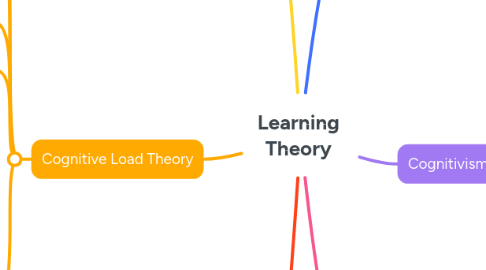
1. Andragogy
1.1. Adult learner takes responsibility for
1.1.1. their own learning
1.1.2. setting goals
1.1.3. evaluating outcomes
1.2. Adult learner shifts conscionsness and reflection on their assumptions
1.3. Adult learner changer their way of thinking about themselves and the world
1.4. How?
1.4.1. more writing
1.4.2. online communication
1.4.3. give feedback to challenge assumptions
2. Cognitive Load Theory
2.1. It's how the brain processes and retain information
2.2. It's the amount of effort required to process information
2.2.1. Intrinsic
2.2.1.1. Inherent complexity of the material learned
2.2.2. Extraneous
2.2.2.1. Extra additional mental effort due to poor or unnecessary information
2.2.3. Germane
2.2.3.1. Mental effort required to process information directly relevant to learning tasks
2.3. Educators help learners understand better by extraneous and gemane cognitive load
2.4. It's more effective when information is presented in a way that minimizes cognitive load
2.5. Human Cognitive Architecture
2.5.1. Biologically Primary Knowledge
2.5.1.1. How?
2.5.1.1.1. Listenning
2.5.1.1.2. Solving unfamiliar problems
2.5.1.1.3. Speaking
2.5.1.1.4. Making future plans
2.5.1.1.5. Recognizing faces
2.5.1.2. Our cognitive systems evolved to allors these skills acquisition with limited effort
2.5.2. Biologically Secondary Knowledge
2.5.2.1. Knowledge our culture determined is important
2.5.2.2. Learning happens by supporting on cognitive structure and systems used to acquire biologically primary knowledge
3. Behaviorisim
3.1. Learner's interaction with the Environment
3.2. Observe and measure observable behavior
3.3. Feedback
3.3.1. Reinforcement
3.3.2. Punishment
3.4. How?
3.4.1. Drill and practice
3.4.2. Repetition
3.4.3. Feedback
4. Constructivism
4.1. Learner creates own understanding of the information
4.2. Active construction of knowledge influenced by
4.2.1. Experience
4.2.2. Beliefs
4.2.3. Values
4.3. How?
4.3.1. Project-based learning
4.3.2. Problem-based learning
4.3.3. Collaboration
4.3.4. Real world context
5. Cognitivism
5.1. Learning new information and integrating it with existing knowledge
5.2. Perception, Memory, and thinking
5.3. Internal mental process
5.4. How?
5.4.1. Memory exercises
5.4.2. Problem solving
5.4.3. Critical thinking
6. Mayer's Cognitive Theory of Multimedia Learning
6.1. People learn better with words and pictures
6.2. Sensory, working, and long-term memory
6.3. 3 assumptions
6.3.1. Active-processing assumption
6.3.2. Dual-channel assumption
6.3.2.1. Visual
6.3.2.2. Auditory
6.3.3. Limited-capacity assumption
